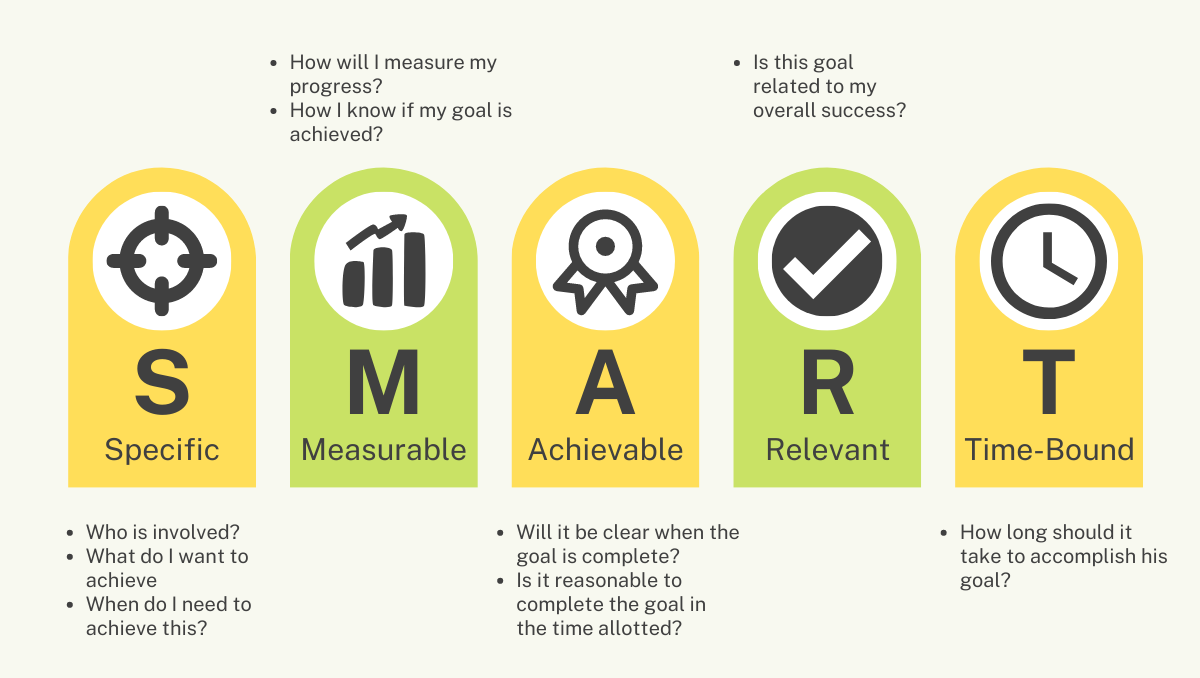Do you feel that you’re working harder and harder but don’t seem to achieve anything?
The answer is to set goals. Goals are a predetermined target that a business or individual plans to achieve in a set period of time. Goals help us maintain focus and direction. They are an essential part of management. Goals help to motivate your teams, they give communication purpose and they’re essential if you’re going to get anything done at all.
The trouble is when you set your goals you can’t simply say something like “I want to increase sales in my company” and then expect that to happen. A goal this undefined is no more than wishful thinking. This is exactly what we want to avoid as all the good stuff associated with goal setting will be lost if the goals themselves are no good.
Setting goals is often challenging. A manager can get lost along the way and elect instead to go with the flow. Setting goals makes people accountable. Be very wary of managers who refuse to set and communicate goals.
SMART Goals
Many companies use the SMART goal setting methodology. It was made famous by my management hero Peter Drucker in his book, Management by Objectives. You may have heard of it so let’s have a look at it in more detail. Writing objectives as SMART statements is the gold standard for goal setting.
SMART is an acronym made up of the first letters of Specific, Measurable, Achievable, Realistic, and Time-bound. A Smart Goal includes all of these criteria. The theory being that if you can tick off all of these attributes in a goal it dramatically increases your chances of success.
Breaking this down in greater detail let’s look at each attribute of the Smart Goal.
Smart Goals are Specific
Goals need to be as clear as possible, there should be no room at all for confusion, they need to be specific. This part comes first because it is the most important to get right. Having a clear picture will make it much easier to achieve your goal and to motivate others to help you achieve it.
It can help if you mindmap the following questions;
- What do I want exactly?
- Why is this important?
- How am I going to achieve it?
- Where is it located?
- Which resources will be required?
If you want to increase sales in your organisation a poor example of a goal would be, “Increase sales” (which is so broad it’s useless). More specifically would need to include how we increase sales, by when, to whom and via which channels.
Smart Goals are Measurable
What gets measured gets done. Your goal needs to be measurable so you can monitor the progress of it over time. This helps you to stay on track and motivated to complete your goal.
A measurable goal could address the following questions:
- How will I measure this goal?
- What do I consider success to look like?
- How will I know when it is completed?
- What are the milestones associated with this goal?
Your goal of increasing sales becomes measurable when specific numbers are involved.
Smart Goals are Achievable
Sounds obvious but the goal needs to be realistic. It needs to be challenging but must be achievable. Carefully consider what competencies will be required by your organisation to complete the goal. It might be that new skills or ways of doing things will have to be developed.
An achievable goal will usually answer questions such as:
- How can we accomplish this goal?
- Have we done something like this before?
- Can we afford it, if not how do we finance it?
Smart Goals are Relevant
Making a goal relevant in a corporate setting means it moves the strategic objectives of your company forward. Smaller goals should be relevant to the broader goals your company and team are working towards.
Ask yourself: Is this goal worthwhile? Is this the right time? Does this match your other efforts and requirements? Is this goal applicable in the current socio-economic environment?
Smart Goals are Time Bound
Without a deadline it is very unlikely the goal will be achieved. Every goal you set will need to be time specific. To help ask yourself these questions.
- When will I complete this goal?
- What can I achieve in 3 months?
- What can I achieve in 12 months?
- What do I need to have complete in the next 6 weeks.
The Anatomy of a Smart Goal
Now that the SMART framework has been considered we can expand on the goal of “increasing sales”. Expanding it to be specific, measurable, achievable, realistic and time-bound we get to something like; “increase the amount of business closed by each sales rep by 10% in the next quarter“.
- Is it specific? Yes. This goal is clear and we can see exactly what it refers to.
- Is it measurable? Yes. The 10% increase is easily measurable.
- Is it achievable? Yes. There might be
- Is it relevant? Yes. We stated earlier we wanted to increase sales.
- Is it time-bound? Yes. The goal is to be completed in the next quarter.
So. We have ourselves a Smart goal. This will dramatically improve your chances of achieving success.
Examples of Smart goals
Here are some examples of Smart goals relating to sales, marketing. These will be different for your company as the variables that drive results in your organisation will no doubt be different. Use each question as a starting point and test each one against the five questions.
Smart Goals for Sales
Here are some examples of Smart goals in a sales context.
- Win 4 new customers each month by improving our online demonstrations.
- Ensure each sales rep attends 3 networking events each month.
- Every month have a meaningful conversation with 10 key customers.
- Decrease the time to close a sale by an average of 2 days.
- Increase the number of demo calls by 15% in the next 3 months by actively suggesting live demos rather
- Ask at least 50% of existing customers for a referral in the next 6 months.
- Convert 5 leads per month per sales rep through proactive outreach.
- Improve customer lifetime value by 10% this year by upselling additional services.
- Increase close ratio by 10% on all accounts next quarter.
- Improve customer loyalty by 15% by the end of the year through loyalty discounts and extended contracts.
Smart Goals for Marketing
Here are some examples of marketing Smart Goals.
- Increase organic website traffic to 10,000 per day in the next 6 months.
- Increase social media lead conversions by increasing social media activity next quarter by 50%.
- Increase customer reviews by 25% in the next six months by following up with high NPS scores and case study participants.
- Gain 20% more LinkedIn followers by taking part in relevant LinkedIn groups within 3 months.
- Increase the number of LinkedIn followers by 20% by sharing 1 piece of video content per week.
- Improve the read rate of the company newsletter by 5% in next 3 months by sharing better quality content.
- Automate email initiatives by the end of the quarter to save 1 hour a day via a more efficient process.
- Generate 150 qualified leads per month by implementing a targeted PPC campaign with a click-through rate (CTR) of at least 5%.
- Improve our Net Promoter Score (NPS) by 2 points for the calendar year so that we can improve our referral rate by 10%.
- Strengthen our backlink profile by obtaining 50 backlinks next quarter from authoritative domains via a link building email campaign.
Smart Goals for HR
A company’s culture directly impacts how business is done. Make sure HR is creating value in your organisation by asking them to create Smart Goals. Here are a few examples.
- Increase staff retention next year to 55%.
- Increase staff engagement levels from 40% to 50% next year.
- Move 50% of HR strategy from long-range planning to 90-day sprints next year.
- Measure the carbon impact of the organisation in the next 6 months.
- Conduct a deep dive next quarter via anon survey to find out what employees need to keep their morale and productivity at peak levels.
- Conduct a review and comparison study of employee benefits and compensation plans in the next 6 months.











Leave a Reply